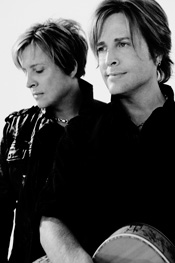Featured Artists: Matthew and Gunnar Nelson
 Let’s be clear about one thing right from the git-go: Rick Nelson — despite his devastatingly good looks — was no mere teen idol. Yes, he was a teenager when both sides of his first single reached the Top 5 in the summer of 1957. And, yes, he appealed to teenaged fans of rock ’n’ roll. Yet he was so much more than that.
Let’s be clear about one thing right from the git-go: Rick Nelson — despite his devastatingly good looks — was no mere teen idol. Yes, he was a teenager when both sides of his first single reached the Top 5 in the summer of 1957. And, yes, he appealed to teenaged fans of rock ’n’ roll. Yet he was so much more than that.
After the first wave of rock ’n’ rollers — Elvis, Chuck Berry, Little Richard, Gene Vincent and the like — he, along with The Everly Brothers and The Crickets/Buddy Holly, made up a second wave of influential artists who took the new sound beyond its rebellious underpinnings into mainstream America and, in doing so, helped ensure its long-term survival.
Some stats for your consideration: Among solo artists of the pre-Beatles rock ’n’ roll era, Elvis was the undisputed leader on Billboard magazine’s Hot 100 with 44 Top 20 single sides. Rick was third with 24, behind Pat Boone’s 26. (It should be noted that Pat released more 45s during that time and, thus, had more shots at the Top 20.)
Like Elvis and the Everlys, Rick had an unerring ear for a great tune. In the words of one of Rick’s twin sons, Gunnar (the other is Matthew), “He picked some amazing songs [including some] legendary rockabilly songs. He wasn’t a writer; he was a translator.”
In the beginning, says Gunnar, “He was a rock fan like all other kids his age. They’d film [“The Adventures of Ozzie and Harriet”] all day, and then he’d go into his bedroom and listen to the 45s that he’d bought at Wallach’s Music City and daydream about that whole thing. He had the option of taking the arguably much easier path of being a film actor, where you have personal assistants and a set schedule, and he decided instead that he was born to rock.”
That “decision” came about in a flash of teenage pique one night when a girl he was trying to impress swooned over the wonderful guy she heard singing on the radio: Elvis Presley. Not to be outdone by Elvis, Rick brashly proclaimed that he, too, was going to make a record (even though he had no plans to do so). Back home, he enlisted dad Ozzie’s help. Ozzie brokered a label deal for Rick, and Rick soon had a double-sided hit record, “A Teenager’s Romance” b/w “I’m Walking.”
Between the fall of 1957 and the spring of 1958, Rick released three more two-sided smash singles that included five of those “legendary” rockabilly songs: “Be-Bop Baby,” “Stood Up,” “Waitin’ In School,” “Believe What You Say,” and “My Bucket’s Got a Hole In It.”
Rick was joined on record by guitarist James Burton, who had created a sinuous solo for Dale Hawkins’ “Susie-Q.” Burton quickly became Rick’s fellow song “translator,” laying down iconic licks and — beginning with “Believe What You Say” — inventing rock lead guitar in the process.
“Our dad was there as a snot-nosed, teenage kid when there were no rules in rock ’n’ roll,” says Gunnar. “Just shooting from the hip and picking great songs and going in with an ace band and playing all this stuff live. Just set up some microphones, and throw it down.”
And throw it down they did. In the summer of 1958, Rick racked up his first Billboard No. 1 with “Poor Little Fool,” which featured the velvety voices of Elvis’ background singers The Jordanaires. The gospel quartet also sang on "Fool’s” follow-up: “Lonesome Town.”
“Lonesome Town,” says Gunnar, “is by far my favorite Rick Nelson song to sing. It’s a really honest, melancholy song and I think my father really identified with it when he chose it. At a time when everybody else was coming up with bigger and bigger productions, our dad bravely put that song out with just an acoustic guitar and a voice, and kicked the crap out of it. That took real stones to do.”
Rick closed out the 1950s with a run of 17 consecutive Top 40 sides (of which 12 went Top 10), then hit a relative slump for 22 months before returning to the top of the charts in May of 1961 with “Travelin’ Man” backed with the No. 9 hit “Hello Mary Lou.” “Travelin’ Man” also marked his public “conversion” from Ricky to Rick in honor of his 21st birthday.
Although he continued to chart, Rick’s peaks trended downward, culminating in “For You,” which reached the Top 10 the same week that The Beatles and “I Want to Hold Your Hand” took over the No. 1 position.
Everyone, except for one of Rick’s good friends, thought that his career was finished. According to Gunnar, “Bob Dylan said to my dad, ‘You know, right at this moment, everybody considers you completely over. They’ve categorized you and written you off as nothing more than what you were.’ He challenged my dad to become the most creative he had ever been, and my dad found that he had great talent as a writer that he tapped into for the first time.”
In the fall of 1969, Rick returned to the Top 30 with Dylan’s “She Belongs to Me.” Backing Rick was the Stone Canyon Band, comprised of ex-Buck Owens and The Buckaroos’ member Tom Brumley, along with seminal country/rock musicians Randy Meisner (future Eagles), and Allen Kemp and Patrick Shanahan (both future New Riders of the Purple Sage). “Our dad was the first guy to put a Marshall half stack right next to a pedal steel,” says Gunnar, “and country-rock was born.”
The criminally overlooked SCB’s third album, “Rudy the Fifth,” has special meaning for Gunnar. “That was when my dad had given up all attachments to the outcome. He had banished the critic that we all have sitting on our shoulder and just allowed himself to be completely, boldly creative, and I can hear the freedom in those grooves. If I were sitting here with my grandchild one day, I’d say, ‘I want you to learn who your great-granddad truly was,’ and I’d play them that album start to finish.”
Then, he adds, came “the record that I love more than any that he sang: ‘Garden Party.’ Not just [because of] the experience that he wrote about, going to Madison Square Garden and getting booed off the stage for looking different. It’s not that. It’s as a fellow musician who has had to run the political gauntlet, as we all do, in this industry. That song was never meant to be on that record; it was never intended to survive.”
“The deal that Ozzie Nelson signed for my dad [with Decca] was unprecedented: a million dollars a year for life. At that particular time, the people at the label felt that they were never going to have another hit on Rick Nelson again, and they were trying to figure out a way to make our dad quit.
“So when he was making records like ‘Rudy the Fifth,’ they put them on auto-flush. They were trying to get him so frustrated that leaving would be his idea.
“So our dad’s in the studio and the head of the label goes to France on vacation. It’s at this time that the garden party experience happened [on Oct. 15, 1971]. Our dad goes back home, writes the song and records it that night, and they put it out as a single. By the time the dude from the record company came back from vacation, Rick Nelson had a runaway hit and they were stuck with him again. To me, that was my father’s defining moment.”
Gunnar and Matthew were just 18 when their dad was killed in a plane crash on New Year’s Eve 1985, four years and ten months shy of their own No. 1 record, “(Can’t Live Without Your) Love And Affection” and 55 years after grandparents Ozzie and Harriet had topped the charts with “And Then Some.” “The only family in history with three generations of No. 1 hit-makers,” says Gunnar proudly.
For the Nelsons, it’s always been about family. “Grandma Harriet told us, ‘Boys, always remember that the Nelson family had never been in the entertainment business; we’ve been in the connection business.’ And, to me, of all the shows I do, 'Ricky Nelson Remembered' is the one where I feel most connected to people.”
For MSMC 2014, says Gunnar, “We’re bringing the big videos, and it’s going to be action-packed, nothing but wall-to-wall hits. We’re also doing a second show — an Evening With... — where we’ll play our stuff.”
“My dad was my hero,” he says quietly, “and as I’m doing ‘Ricky Nelson Remembered,’ I’m getting to see that he was a hero to a lot of other people, too. That makes me feel proud to be from this family and to be his son and to carry on his legacy in any small way that I can. This is what I honestly feel I was born to do.
“It’s something that I don’t have to do; it’s something I get to do. I feel that way every single day. When I go on this rock cruise, I’m going to play that show like a guy who gets to do it, not someone who has to do it.”
Matthew Nelson recently spoke to WGNY’s morning DJ, Van Ritshie, about his famous family and his excitement on joining our cruise this November. Listen to the interview.
Be sure to book your cabin on Malt Shop Memories Cruise 2014, so you can see Gunnar and Matthew Nelson pay tribute to their dad with "Ricky Nelson Remembered."
